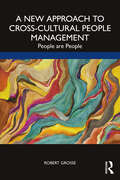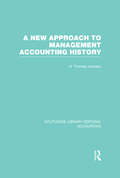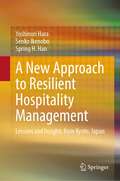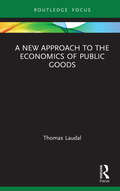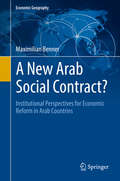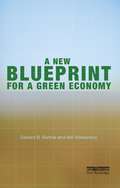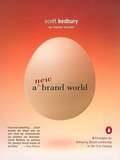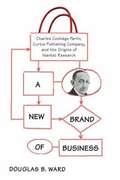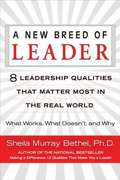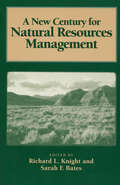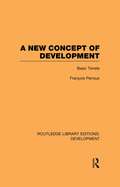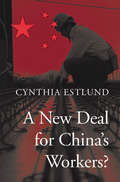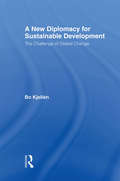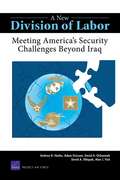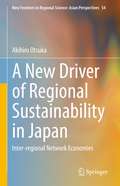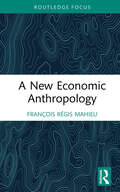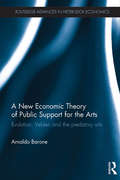- Table View
- List View
A New American Tea Party: The Counterrevolution Against Bailouts, Handouts, Reckless Spending, and More Taxes
by Michelle Malkin John M. O'HaraAn engaging look behind the modern day tax tea parties. What has driven hundreds of thousands of people to take to the streets in protest since late February, 2009? A cry of "enough" government expansion and interference and reassertion of individual liberty: a first principle that became a rallying cry behind a movement. A New American Tea Party presents the voices behind the growing discontent among every day citizens with increased government taxation, spending, and intervention. Author John M. O'Hara - a rising star in the conservative/libertarian movement - played an integral role in starting the first modern day tea party in February of 2008, an effort that sparked off a nation wide movement. On tax day in April 2009, hundreds of thousands of citizens gathered in more than 800 cities to voice their opposition to out of control spending at all levels of government. In August, citizens in every state of the union made their voices heard at congressional town hall meetings. On September 12, 2009 over half a million people marched on the U. S. Capitol. A New American Tea Party explains how these protests evolved and were organized, and distills the results-including the often bizarre media backlashes-of the movement, the philosophy behind the movement, and the road ahead. Written by one of the leading organizers behind the protests, this book shows you how the costs of bailouts and other excessive government interference today is philosophically incompatible with the founding principles of our nation and simply unsustainable for future generations. Skillfully lays out the case against excessive government interference and why the tea party movement is necessary and significant Written by one of the top organizers and leaders of the tea party movement Offers a look into current and future policy battles and how the movement will grow in responseIf you're concerned with the growth of government, the state of the union we will pass on to the next generation, and you want to see a roadmap for a better way forward, then you need to read A New American Tea Party.
A New Approach To Sovereign Debt Restructuring
by Anne O. KruegerA report from the International Monetary Fund.
A New Approach to Cross-Cultural People Management: People are People
by Robert GrosseWhen managing cross-culturally in a polarized world, recognizing similarities between people and establishing common ground can be key to success. This book argues that despite differences in language, political systems, income levels, and other factors, people are people. There is no doubt that cultural differences should be understood and appreciated, not only because this is the right thing to do in a multicultural world, but because failure to understand these differences when doing business can result in costly mistakes. But when managing people, what matters most is showing respect and interest – because what motivates (and de-motivates) is the same regardless of cultural background. This book explains and illustrates eight themes in which people are very similar across cultures, including trust, fairness, integrity, and, though often overlooked in an organizational context, the reasons why people work. Business leaders, human resource professionals, organizational consultants, and students in these fields will appreciate this fresh perspective on people management, and the mini-cases and interviews with senior executives provide inspiring real-world examples.
A New Approach to Management Accounting History (Routledge Library Editions: Accounting)
by H. Thomas JohnsonThe articles and papers reprinted in this volume, all written after 1970, represent a departure from the earlier conventional notion of accounting history research. They approach the study of management accounting history by regarding the accounting and business records of actual organizations as indispensable source materials for historical analysis. Analysis of these records has yielded a new conception of management accounting. These studies suggest that the forces contributing to management accounting’s development are more numerous and complex than historians had realized. The case studies in the first part of the book trace the historical development of virtually all the internal accounting practices associated today with management accounting. Those in the second section consist of articles which interpret the case material.
A New Approach to Resilient Hospitality Management: Lessons and Insights from Kyoto, Japan
by Yoshinori Hara Spring H. Han Senko IkenoboThis book includes lessons and insights from the hospitality management approach of Japanese sustainable organizations, as well as philosophical underpinnings and numerous business practice examples. The "Japanese manner" of providing customer service and hospitality is well-known around the globe. Traditionally, Japanese organizations have specific but implicit standards for how to approach customers and other multi-stakeholders, exhibiting respect and omnipresence. Japanese hospitality is complicated, nuanced, and changing in tandem with Japanese culture. The book presents sustainable and resilient management of society, organizations, and businesses. Kyoto, in particular, is regarded as Japan's cultural capital, and it is home to not only numerous architectures classified collectively by UNESCO, but also to distinctive Japanese hospitality, customs, philosophy, and ethics. The book is a useful resource for academics and business practitioners interested in the hospitality management, service management, and human resource management. The lessons and insights in this book will also throw light on the future course of the post-pandemic era with modern technologies and their transformation.
A New Approach to the Economics of Public Goods (Routledge Frontiers of Political Economy)
by Thomas LaudalPublic goods are typically defined only in reference to the good itself but, as this book argues, the public goods can be better understood if contextual variables are incorporated. This book discusses the production and provision of public goods. It asserts that changes related to public goods are better understood if the category of goods are not decided solely by the properties of the good itself. We also need to focus on how the enabled utility of a good is influenced by the production and the provision of the good. The book opens with a brief introduction to common conceptions of public goods and a review of the existing literature - highlighting the limitations of current definitions of public goods. It presents a new multi-layered approach to public goods. This has implications for the discourse on public goods and for our understanding of the societal and environmental impact of public goods. The implications are illustrated in several areas; public goods in ancient history, privatization, innovation, competitiveness and prices, democracy and political standards, and economic growth. The book provides a provocative argument for a new way to analyze public goods which will appeal to scholars and students interested in the economic analysis of public goods, arguments regarding the privatizing or nationalizing of production and services, and method of modelling and measuring sustainable business activities.
A New Arab Social Contract?: Institutional Perspectives for Economic Reform in Arab Countries (Economic Geography)
by Maximilian BennerThis monograph offers a unique conceptual bridge between economic geography and Middle Eastern political economy. Arab economies are confronted with enormous structural difficulties such as high rates of youth unemployment in a challenging demographic context, exacerbated by intense spatial disparities. These structural problems demonstrate the breakdown of the "Arab social contract", a social arrangement centered on a strong role of the state in welfare and employment provision, for which regimes demanded acquiescence to authoritarian rule. The book argues that the Arab social contract can be understood in terms of regulation theories known in economic geography and sociology. It uses the approaches such as the regulation school, national systems of innovation, social systems of production, and varieties of capitalism to analyze the structural difficulties of Arab economies and current reform efforts. The basic assumption is that Arab economies are currently faced with a structural crisis. After the breakdown of the Arab social contract, there is a mismatch between the economic and institutional spheres of society. The challenge is for Arab societies to develop new forms of socio-institutional regulation. The book proposes ways towards such new modes of regulation by developing a framework for regulation specifically targeted towards Arab societies, and by applying it to the cases of Tunisia and Jordan.
A New Balance of Payments for the United States, 1790–1919: International Movement of Free and Enslaved People, Funds, Goods and Services (Palgrave Studies in American Economic History)
by Lawrence H. OfficerThis book develops new balance of payments statistics for the United States from 1790 to 1919, before official statistics were kept. Part I of this book justifies construction of a new balance of payments table, and Chapter 1 surveys existing tables from that standpoint. Chapter 2 shows how this book overcomes the limitations of Office of Business Economics and its North-Simon-Goldsmith foundation. Specific features are highlighted, including measurement decisions, improvement of OBE series, development of new series, and derived implications for the structure of the US economy and for the importance of individual sectors that loom large at various times: slave trade, shipping, manufacturing, and travel. The book then generates new time series of the movement of people, the movement of goods, the movement of funds, and the provision of services. Part VI puts the new balance of payments table to use in several ways: aggregates and balances within the table, structure of the US economy, and specific sectors of the economy (slave trade, shipping, manufacturing, travel). Finally, Part VII provides concluding comments.
A New Blue Ocean: Prospects for Latin American SMEs in the Belt and Road Initiative
by Yihai Li Aníbal Carlos ZotteleThis book explores the achievements and obstacles confronting China and major Latin American countries in developing small- and medium-sized enterprises (SMEs) in the context of new changes in “The Belt and Road” Initiative. In the first three chapters, the Chinese authors elaborate on the relationship between “The Belt and Road” Initiative and globalization, as well as strategies towards forming an increasingly close bond between China and Latin America. The book ends with chapters dedicated to analyzing the BRI conditions and effects on SMEs of Latin-American countries. These country specific chapters will show the specific opportunities and challenges the countries conditions, be they political, geological, etc. may have on the development of SMEs under the BRI. The book will be useful not only to industry leaders looking to better understand how they can potentially benefit from the BRI but also by the general public, as the book will explain what this new era of globalization, and more specifically the BRI, will mean for the world’s industries and society.
A New Blueprint for a Green Economy
by Edward B. Barbier Anil MarkandyaPublished in 1989, Blueprint for a Green Economy presented, for the first time, practical policy measures for 'greening' modern economies and putting them on a path to sustainable development. This new book, written by two of the Blueprint for a Green Economy authors, revisits and updates its main messages by asking, first, what has been achieved in the past twenty years, and second, what more needs to be done to generate a truly 'green economy' in the twenty-first century? Blueprint for a Green Economy had one over-arching theme. Making economies more sustainable requires urgent progress in three key policy areas: valuing the environment, accounting for the environment and incentives for environmental improvement. Today, with the threat of global warming, the decline in major ecosystems and their services, and fears over energy security, achieving these goals is even more vital. The current book first summarizes the main messages from Blueprint for a Green Economy and explains why, given rapid and widespread global environmental degradation, they are still relevant. The book then examines the progress since Blueprint for a Green Economy in implementing policies and other measures to improve environmental valuation, accounting and incentives. Although much has been accomplished, additional advances are still required to green economies successfully. The book highlights the new policies and approaches needed for economic management of today's environmental concerns. Over twenty years later, A New Blueprint for a Green Economy once again emphasizes practical policies for greening modern economies, and explains why such an economic roadmap to a greener future is essential, if modern economies are to develop successfully and sustainably.
A New Brand World
by Scott BedburyNo company can succeed without a great product or service, but in today's competitive market it also needs a brand. Transcending the tangible aspects of a commodity and nurturing a brand to build a deeper and more enduring emotional connection with customers has become one of the most critical and complex challenges facing businesses today, whether they are multinational corporations or small, local enterprises. How did a company like Nike use "Just Do It" to launch its way to success and become part of global culture? How did Starbucks reinvent a familiar 900-year-old product and change the way people drink coffee around the world? In A New Brand WorldScott Bedbury, who was at the heart of both companies as they became two of the greatest branding success stories of our time, explains how to apply the principles that grew these companies more than fivefold and established their trademarks as leaders in their categories. With fascinating anecdotes from his own in-the-trenches experience and dozens of case studies (including companies like Harley-Davidson, Guinness, the Gap, and Disney), Bedbury offers practical, battle-tested advice and an analysis of why some brands succeed where others fail. A New Brand Worldwill show any business-whether a Fortune 500 corporation or a neighborhood store-how it can begin to realize its full brand potential and build lasting value. Inspiring, visionary, and witty, A New Brand Worldwill become the key book for building brands in the twenty-first-century economy.
A New Brand of Business: Charles Coolidge Parlin, Curtis Publishing Company, and the Origins of Market Research
by Ward Douglas B.Charles Coolidge Parlin was considered by many to be the founder of market research. Working for the dominant Curtis Publishing Company, he revolutionized the industry by providing added value to advertisers through information about the racial, ethnic, and regional biases of readers and consumers. By maintaining contact with both businesses and customers, Parlin and Curtis publications were able to turn consumer wants into corporate profits. InA New Brand of Business, Douglas Ward provides an intriguing business history that explains how and why Curtis developed its market research division. He reveals the evolution and impact of Parlin's work, which understood how readers and advertisers in the emerging consumer economy looked at magazines and advertisements. Ward also examines the cultural and social reasons for the development and use of market research-particularly in regard to Curtis' readership of upper-income elites. The result weaves the stories of Parlin and Curtis into the changes taking place in American business and advertising in the early twentieth century.
A New Brand of Expertise: How Independent Consultants, Free Agents, And Interim Managers Are Transforming The World Of Work
by Dennis Russell Marion McGovernA New Brand of Expertise uniquely clarifies the dynamics of the red-hot "free agent" workplace and teaches the new skills and employment strategies independent professionals must master to succeed. In today's quick and turbulent markets, companies often need specialized professional talent on an interim basis to solve specific business problems, a major trend creating huge opportunities and an alternative career track for many professionals. A New Brand of Expertise clarifies for independent professionals why companies need interim talent and how to develop a skill set that matches market needs. Readers will learn effective methods for uniquely marketing and branding themselves in order to develop a sustainable and successful free agent career.
A New Breed of Leader
by Sheila Murray BethelThe author of the national bestseller Making a Difference presents the indispensable characteristics every twenty-first century leader needs. In A New Breed of Leader, Dr. Sheila Murray Bethel-global leadership expert, bestselling author, and award-winning speaker-will show readers how to develop the essential qualities needed to become an effective leader: ? Competence-building purpose ? Accountability-fostering trust ? Openness-generating integrity ? Humility-inspiring authenticity ? Language-connecting relationships ? Values-forging community ? Perspective-establishing balance ? Power-mastering influence Filled with stories about and interviews with successful leaders such as golf legend Arnold Palmer; Andrea Young, CEO Avon Corporation; Howard Schultz, CEO Starbucks; and David Neeleman, CEO JetBlue; this book offers valuable insights and teaches readers how to take advantage of the immediately usable action steps.
A New Breed of Leader: 8 Leadership Qualities That Matter Most in the Real World What Works, What Doesn't, and Why
by Sheila Murray BethelThe author of the national bestseller Making a Difference presents the indispensable characteristics every twenty-first century leader needs. In A New Breed of Leader, Dr. Sheila Murray Bethel-global leadership expert, bestselling author, and award-winning speaker-will show readers how to develop the essential qualities needed to become an effective leader: ? Competence-building purpose ? Accountability-fostering trust ? Openness-generating integrity ? Humility-inspiring authenticity ? Language-connecting relationships ? Values-forging community ? Perspective-establishing balance ? Power-mastering influence Filled with stories about and interviews with successful leaders such as golf legend Arnold Palmer; Andrea Young, CEO Avon Corporation; Howard Schultz, CEO Starbucks; and David Neeleman, CEO JetBlue; this book offers valuable insights and teaches readers how to take advantage of the immediately usable action steps.
A New Century for Natural Resources Management
by Robert Costanza Sarah F. Bates Vawter Parker Richard L. Knight Steward Pickett Peter BerckThis book explores the changes that are leading to a new century of natural resources management. It places the current situation in historical perspective, analyzes the forces that are propelling change, and describes and examines the specific changes in goals, policy, and practice that are transforming all aspects of natural resources management.The book is an important overview for wildlife biologists, foresters, and others working for public land agencies; professors and students of natural resources; and all those whose livelihood depends on the use of public natural resources.
A New Concept of Development: Basic Tenets (Routledge Library Editions: Development)
by François PerrouxFirst published in 1983, François Perroux’s A New Concept of Development analyses the major paradox of our era: the desire for progress and the mistrust of its consequences. The authors argues that the approach to the question of development may be the key to understanding both the present and what the future brings, representing a pattern which will seek to shape man’s potential to his designs. By analysing the ideas and theories propounded by the economic approach the author’s aim is to clarify both the meaning and direction of research in development. A scientific, oriented economy and efficient strategies should and must be the two components of one and the same momentum, required to go beyond the perilous paradox of our era.
A New Database of Financial Reforms
by Thierry Tressel Enrica Detragiache Abdul AbiadA report from the International Monetary Fund.
A New Deal for China’s Workers?
by Cynthia EstlundChina’s leaders aspire to the prosperity, political legitimacy, and stability that flowed from America’s New Deal, but they are irrevocably opposed to the independent trade unions and mass mobilization that brought it about. Cynthia Estlund’s crisp comparative analysis makes China’s labor unrest and reform legible to Western readers.
A New Deal for Old Age: Toward a Progressive Retirement
by Anne L. AlstottAs America’s haves and have-nots drift further apart, rising inequality has undermined one of the nation’s proudest social achievements: the Social Security retirement system. Unprecedented changes in longevity, marriage, and the workplace have made the experience of old age increasingly unequal. For educated Americans, the traditional retirement age of 65 now represents late middle age. These lucky ones typically do not face serious impediments to employment or health until their mid-70s or even later. By contrast, many poorly educated earners confront obstacles of early disability, limited job opportunities, and unemployment before they reach age 65.<P><P> America’s system for managing retirement is badly out of step with these realities. Enacted in the 1930s, Social Security reflects a time when most workers were men who held steady jobs until retirement at 65 and remained married for life. The program promised a dignified old age for rich and poor alike, but today that egalitarian promise is failing. Anne L. Alstott makes the case for a progressive program that would permit all Americans to retire between 62 and 76 but would provide more generous early retirement benefits for workers with low wages or physically demanding jobs. She also proposes a more equitable version of the outdated spousal benefit and a new phased retirement option to permit workers to transition out of the workforce gradually.<P> A New Deal for Old Age offers a pragmatic and principled agenda for renewing America’s most successful and popular social welfare program.
A New Diplomacy for Sustainable Development: The Challenge of Global Change (Routledge/SEI Global Environment and Development Series)
by Bo KjellénAccelerating, human-induced changes in global natural systems, with global warming as a prime example, are modifying international relations. Diplomacy has to recognize that new types of threats will require new solutions and a new spirit of cooperation. This is a gradual process; traditional conflicts will continue to haunt the international system and traditional methods of diplomatic work still prevail. Based on forty years of experience in multilateral negotiations as former diplomat and international negotiator, the author has developed the concept of a New Diplomacy for Sustainable Development. The book develops the theoretical foundations of the concept and links it to the notion of enabling conditions, describing the close linkages between domestic policies and international negotiations. In conclusion, Kjellén comments on present negotiation processes and offers ideas for institutional reform of the international system.
A New Division of Labor: Meeting America's Security Challenges Beyond Iraq
by Andrew R. Hoehn Alan J. Vick David Ochmanek David A. Shlapak Adam GrissomAn emerging U.S. grand strategy--the promotion of democracy and freedom abroad--will certainly involve the U.S. armed forces. Although they must change to meet changes in emphasis and demand, they cannot risk their historic strengths. Some areas of interest are the organization and employment of forces, planning for future conflicts, developing information resources, and fostering partnerships among the services and with allies.
A New Driver of Regional Sustainability in Japan: Inter-regional Network Economies (New Frontiers in Regional Science: Asian Perspectives #54)
by Akihiro OtsukaThis book highlights the roles of inter-regional networks in regional economies to explore the drivers of sustained regional economic growth. Many industrialized countries are currently undergoing a period of population decline. To enhance sustainability in the regional economy, it is necessary to increase productivity and improve energy efficiency. This book provides new approaches to describing the economic effects of inter-regional networks, which are key to enhancing regional economic growth, using productivity analysis. In addition, it also furnishes considerable evidence on the formation of high-speed transportation infrastructure. Traditional studies on agglomeration economies have focused on external economies that occur in spatially limited areas and have not considered agglomeration economies from a broader perspective, i.e., from the perspective of inter-regional networks. In particular, recent studies have identified that the actual spatial range that would benefit from agglomeration economies is broader than that covered by conventional studies. This volume explains the phenomenon using Alonso’s concept of borrowed size. This is the first book to show the impact of inter-regional networks on Japan’s regional economy using the concept of the borrowed-size effect. Based on empirical evidence, the roles of inter-regional networks are determined in the context of the regional economy that faces population decline and environmental constraints. A deeper consideration of the analytical methods and understanding the results of detailed analyses will make it possible to propose desirable regional economic policies in the face of population decline. This book thus provides valuable insights into the regional economic development of Japan, which is particularly pertinent to other countries with similar land structures.
A New Economic Anthropology (Economics and Humanities)
by François Régis MahieuTraditionally economic anthropology has been studied by sociologists, anthropologists, and philosophers seeking to highlight the social foundations of economic action. Meanwhile, anthropological questions have remained largely untreated in economics, despite the prominence given to the individual in microeconomics. And there is very little in the way of dialogue between the two sides. This book argues for a new economic anthropology which goes beyond the conflict of economics and anthropology to show the complementarity of the two approaches. Economics needs to go beyond the stage of homo oeconomicus and be open to broader ideas about the person. Equally, anthropology can be enriched through the methods and models of economic theory. This new economic anthropology goes beyond a simple observation of societies. It is new because it introduces the responsible person with a wider range of characteristics, in particular vulnerability and suffering, as a subject of economics. It is a particular interpretation of economic anthropology calling for a broadening of the subject (moving from the individual to the person), range of values (admission of negative values for altruism, social capital, responsibility), and disciplinary references. Through this approach, both economics and anthropology can be enriched. This book will be of great interest to those working in the fields of economics, anthropology, philosophy, and development studies.
A New Economic Theory of Public Support for the Arts: Evolution, Veblen and the predatory arts (Routledge Advances in Heterodox Economics)
by Arnaldo BaroneShould the arts receive public support? Can the arts survive in a modern capitalist society? Can economics shed light on the nature of public support, and whether there is a rationale for public intervention? This book undertakes to examine these questions as it explores the ways government and public resources are used to support the arts. This book applies a Veblenian approach to understanding economic development to investigate public support for the arts in an effort to determine whether this approach can elucidate economic rationales for public support. Divided into three parts, the first provides basic information on public support for the arts by surveying support in the United States and Australia. Part two includes a neoclassical overview of the topic while part three presents Veblen’s ideas on economic development. This book will be of interests to researchers concerned with cultural and institutional economics, as well as political economy.


